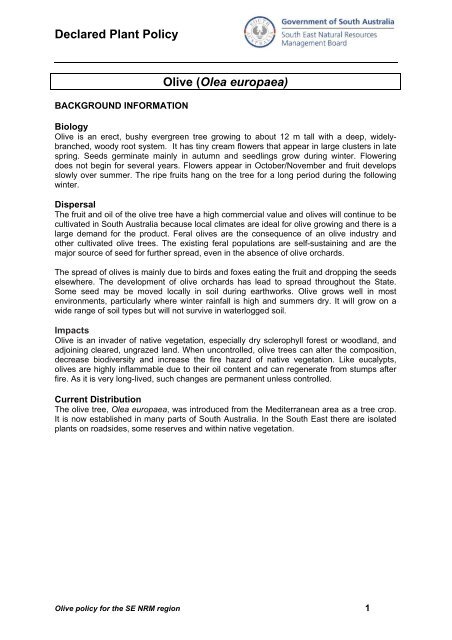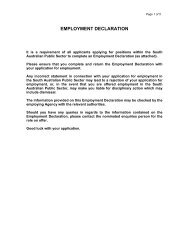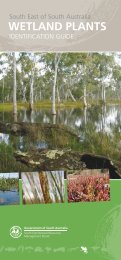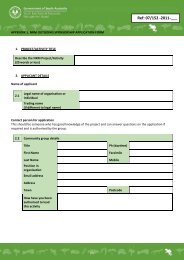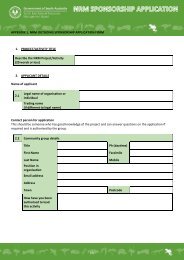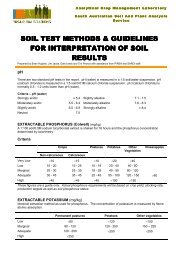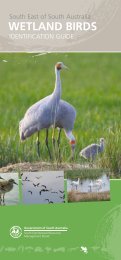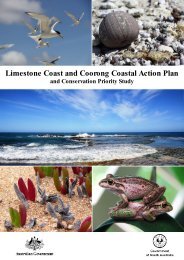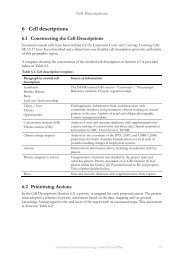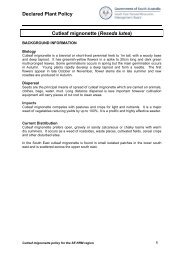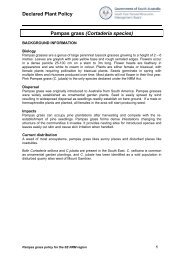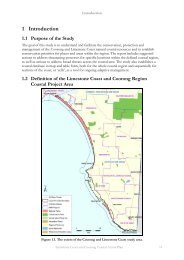Olive policy - South East Natural Resources Management Board ...
Olive policy - South East Natural Resources Management Board ...
Olive policy - South East Natural Resources Management Board ...
You also want an ePaper? Increase the reach of your titles
YUMPU automatically turns print PDFs into web optimized ePapers that Google loves.
Declared Plant Policy<br />
BACKGROUND INFORMATION<br />
<strong>Olive</strong> (Olea europaea)<br />
Biology<br />
<strong>Olive</strong> is an erect, bushy evergreen tree growing to about 12 m tall with a deep, widelybranched,<br />
woody root system. It has tiny cream flowers that appear in large clusters in late<br />
spring. Seeds germinate mainly in autumn and seedlings grow during winter. Flowering<br />
does not begin for several years. Flowers appear in October/November and fruit develops<br />
slowly over summer. The ripe fruits hang on the tree for a long period during the following<br />
winter.<br />
Dispersal<br />
The fruit and oil of the olive tree have a high commercial value and olives will continue to be<br />
cultivated in <strong>South</strong> Australia because local climates are ideal for olive growing and there is a<br />
large demand for the product. Feral olives are the consequence of an olive industry and<br />
other cultivated olive trees. The existing feral populations are self-sustaining and are the<br />
major source of seed for further spread, even in the absence of olive orchards.<br />
The spread of olives is mainly due to birds and foxes eating the fruit and dropping the seeds<br />
elsewhere. The development of olive orchards has lead to spread throughout the State.<br />
Some seed may be moved locally in soil during earthworks. <strong>Olive</strong> grows well in most<br />
environments, particularly where winter rainfall is high and summers dry. It will grow on a<br />
wide range of soil types but will not survive in waterlogged soil.<br />
Impacts<br />
<strong>Olive</strong> is an invader of native vegetation, especially dry sclerophyll forest or woodland, and<br />
adjoining cleared, ungrazed land. When uncontrolled, olive trees can alter the composition,<br />
decrease biodiversity and increase the fire hazard of native vegetation. Like eucalypts,<br />
olives are highly inflammable due to their oil content and can regenerate from stumps after<br />
fire. As it is very long-lived, such changes are permanent unless controlled.<br />
Current Distribution<br />
The olive tree, Olea europaea, was introduced from the Mediterranean area as a tree crop.<br />
It is now established in many parts of <strong>South</strong> Australia. In the <strong>South</strong> <strong>East</strong> there are isolated<br />
plants on roadsides, some reserves and within native vegetation.<br />
<strong>Olive</strong> <strong>policy</strong> for the SE NRM region 1
Declared Plant Policy<br />
<strong>Olive</strong> <strong>policy</strong> for the SE NRM region 2
Declared Plant Policy<br />
REGIONAL PRIORITY<br />
<strong>Olive</strong> was assessed during the <strong>South</strong> <strong>East</strong> Weed Risk Assessment project. <strong>Olive</strong> is mainly a<br />
weed of native vegetation and was not considered important in the other landuses.<br />
<strong>Olive</strong> was not included in the top 15 agricultural weeds for the <strong>South</strong> <strong>East</strong>.<br />
The table below outlines the management actions required and relative priorities for olive in<br />
each landuse:<br />
<strong>Management</strong><br />
Action<br />
Relative<br />
priority<br />
Aquatic Crop/pasture Forestry Grazing Irrigated Native<br />
Vegetation<br />
Perennial<br />
Horticulture<br />
Urban<br />
N/A N/A N/A N/A N/A Manage N/A N/A<br />
Sites<br />
- - - - - 5 - -<br />
AIMS:<br />
1. To protect natural environments from the loss of biodiversity caused by olive.<br />
2. To protect the olive industry from pests and pathogens harboured by feral olive trees.<br />
3. To reduce the distribution of olive in the <strong>South</strong> <strong>East</strong>.<br />
OBJECTIVES:<br />
• Identification of the full extent of olive infestations in the <strong>South</strong> <strong>East</strong>.<br />
• Enforce control of olive infestations on roadsides and unused plantations to prevent<br />
spread to other areas.<br />
• Identification of important sites to be protected from olive.<br />
• Increase awareness about the impacts of olive.<br />
IMPLEMENTATION<br />
State Level<br />
• Increase awareness about the impacts of olive on native vegetation.<br />
Regional Priority Actions for the SE NRM <strong>Board</strong><br />
• Authorised Officers to inspect, map and monitor all infestations of olives.<br />
• Control of olive enforced for isolated infestations and on roadsides.<br />
• Buffer zones enforced around all plantations of olive.<br />
• Seek external funding for projects relating to olive control which will protect natural<br />
environments.<br />
• Provide risk assessment input to Local Government planning procedures regarding<br />
approval for new olive plantations.<br />
<strong>Olive</strong> <strong>policy</strong> for the SE NRM region 3
Declared Plant Policy<br />
Local action<br />
• All landholders to implement active control programs according to seasonal<br />
conditions and the instructions of the Authorised Officer.<br />
DECLARATIONS<br />
The following sections of the NRM Act apply to olives (that are not planted and maintained<br />
for domestic or commercial use) in all Local Government areas in the <strong>South</strong> <strong>East</strong> NRM<br />
region:<br />
182 (2)<br />
(3)<br />
Land owner must control the plant on their land<br />
Land owner must take prescribed measures for the control of<br />
the plant on their land<br />
185 (1) NRM authority may recover costs for control of weeds on<br />
roadsides from adjoining land owners<br />
Implementation<br />
Responsibility of Operations Manager<br />
Periodic Review<br />
Responsibility of Operations Manager<br />
Date endorsed by the SENRMB 24 May 2006<br />
Date scheduled for review 2011<br />
Version Date Version Reference Sections Description of Changes<br />
May 2006 1 Whole document Endorsed By SENRM <strong>Board</strong><br />
Released to public<br />
March 2011 2 Whole document Review and update of distribution maps<br />
<strong>Olive</strong> <strong>policy</strong> for the SE NRM region 4


